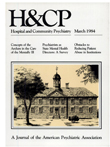Identifying Common Errors in the Use of DSM-III Through Diagnostic Supervision
Abstract
The authors describe the use of diagnostic supervision to identify common errors made by trainees in the application of DSM-lII to multiaxial evaluations in an outpatient clinic. Errors on all five axes were due primarily to misapplications ofdiagnostic criteria and conventions. Errors on axes I, IV, and V were most frequent. Axis I errors were cornrnonly due to confusion about the relationship of dysthyrnic disorder to major depression, neglect of substance use disorder diagnoses, and misuse of the adjustment disorder and V-code categories. On axis JV, the severity of psychosocial stressors was frequently overrated, based on severa! misconceptions. Axis V ratings were often erroneously over estimated because they were individualized rather than made on a uniform scale. No differences were found in the error rates of psychiatric residents compared with psychology interns except on axis 1, where interns made more errors. The authors discuss the implications of these errors for training residents and psychology interns in the use of DSM-llI.
Access content
To read the fulltext, please use one of the options below to sign in or purchase access.- Personal login
- Institutional Login
- Sign in via OpenAthens
- Register for access
-
Please login/register if you wish to pair your device and check access availability.
Not a subscriber?
PsychiatryOnline subscription options offer access to the DSM-5 library, books, journals, CME, and patient resources. This all-in-one virtual library provides psychiatrists and mental health professionals with key resources for diagnosis, treatment, research, and professional development.
Need more help? PsychiatryOnline Customer Service may be reached by emailing [email protected] or by calling 800-368-5777 (in the U.S.) or 703-907-7322 (outside the U.S.).



